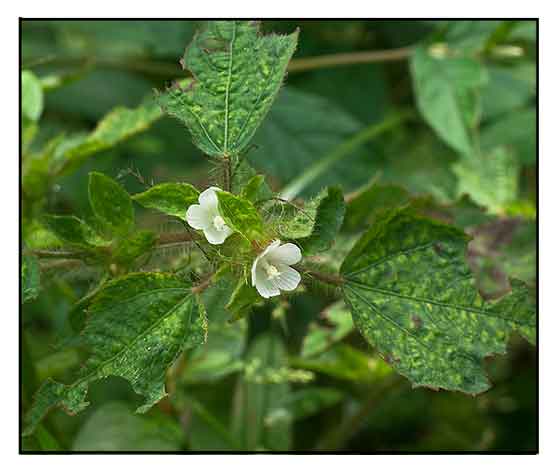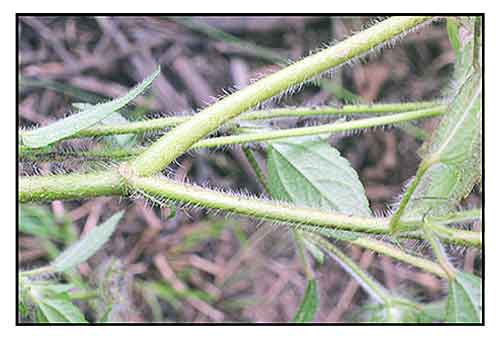 Gen info Gen info
- Lachrymal is a genus of flowering plants in the Malvaceae family, native to the Americas and Africa, and introduced in Asia.
Botany
Malachra fasciata is an erect annual woody herb, up to 2.5 m tall, green parts covered only with stiff simple hairs about 3.5 mm long, usually without minute stellate hairs. Leaves with petiole up to 12 cm long; stipules filiform, 2-3 cm long, ciliate with stiff hairs; blade circular to ovate, 3-15 cm × 2-14 cm, base rounded to shallowly cordate, 5-veined, margin coarsely serrate to crenate, apex 3-5-lobed or deeply 3-5-7-parted, both sides with scattered, appressed, simple hairs. Inflorescence a 6-9-flowered head; peduncle up to 1.5 cm long; bracts 3-4, triangular, 1-2.5 cm × 0.5-2 cm, folded along the midrib; calyx cup 4 mm long, segments ovate-acute-aristate, 2.5 mm × 1.5 mm; corolla 1-1.5 cm in diameter, white but turning red finally, petals obovate; staminal column 3 mm long. Fruit 3-4 mm in diameter, mericarps obovoid, 2.5-3 mm × 1.5-2 mm. Seed triangular-obovoid, about 2.5 mm long, black, glabrous but hilum stellate-hairy. (1)
 Distribution Distribution
- Introduced and naturalized.
-
Occurs in waste places and on roadsides at low altitudes.
- In the Philippines, abundant in wet locations, and grows as a weed in fallow rice fields.
(1)
- In northeast Brazil, considered an invasive plant.
Constituents
- Study of a chloroform extract of air-dried leaves of Malachra fasciata yielded aurantiamide acetate. (see study below) (7)
- Extracts yielded a mixture of 1,2- and 1,3-diacetylglycerol. (see study below)
(8)
Properties
- Studies have suggest antimutagenic, antibacterial, antifungal, photosensitizing properties.
Parts used
Leaves, roots.
Uses
Folkloric
- In the Philippines, poultices of leaves applied to ulcers and other sores. Roots and leaves used as emollient and treatment of hemorrhoid, fever, impotency, and as a general tonic. Decoction of leaves used for treatment of gonorrhea and rheumatism, and as demulcent and diuretic. (7)
Studies
• Primary Photosensitization and Contact Dermatitis: Study evaluated the claim of Brazilian farmers that M. fasciata causes cutaneous lesions in sheep. Sheep were fed daily ad libitum with the plant as sole food with doses varying from 129 g/kg to 175 g/kg.. Cutaneous lesions of photosensitization were observed after 7 days. Alopecia, hyperemia and crusting were observed. No liver alteration were observed at necropsy. Skin histopathology included acanthosis, orthokeratosis, and multifocal infiltration by lymphocytes, eosinophils and plasma cells around blood vessels and dermal appendages. The lesions regressed 2 weeks after end of administration and protection from sunlight. Results suggest primary photosensitization and contact dermatitis. (4)
• Antimutagenic / Loliolide / Leaves: Study isolated a monoterpene from the leaves of M. fasciata by gravity column chromatography, and tested for antimutagenicity potential by Micronucleus test in Swiss albino mice. The monoterpene was identified as loliolide. Results showed a 64.4% reduction in micronucleated polychromatic erythrocytes induced by mitomycin C. (5)
• Loliolide: Loliolides is the most common of the monoterpenoid lactones, which is found in animals (insects), and plants (flowers, shrubs, tress) both terrestrial and marine, such as algae and corals. The compound has been attributed various biological properties such as anti-cancer, antibacterial, antifungal, and antioxidant. Plants containing loliolide are used in traditional medicine for treatment of diabetes and depression. However, there are side effects related to structural analogues of loliolide believed to contribute to extinction of tropical coral. (6)
• Antimicrobial / Leaves: Study of a chloroform extract of air-dried leaves of Malachra fasciata yielded aurantiamide acetate. The compound was found active against P. aeruginosa, B. subtilis, C. albicans, and T. mentagrophytes, and inactive against S. aureus, E. coli, and A. niger. It reduced the number of micronucleated polychromatic erythrocytes induced by mitomycin by 32%. (7)
• Antifungal Diacetylglycerols / Antibacterial: Extracts of Malachra fasciata and Pithecolobium dulce yielded a mixture of 1,2- and 1,3-diacetylglycerol. The diacetylglycerols indicated high antifungal activity against Aspergillus niger, moderate activity against P. aeruginosa, and Candida albicans and slight activity against B. subtilis. (8)
Availability
Wild-crafted.
|

![]()



 Gen info
Gen info Distribution
Distribution